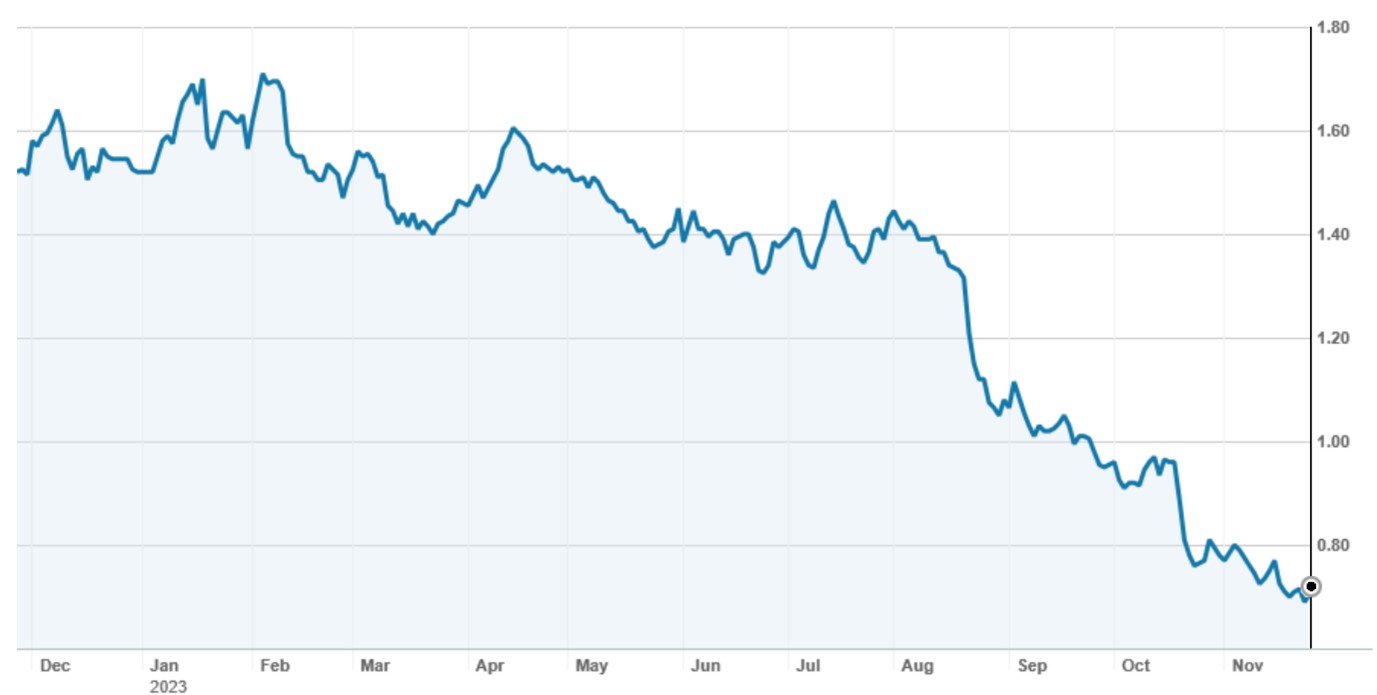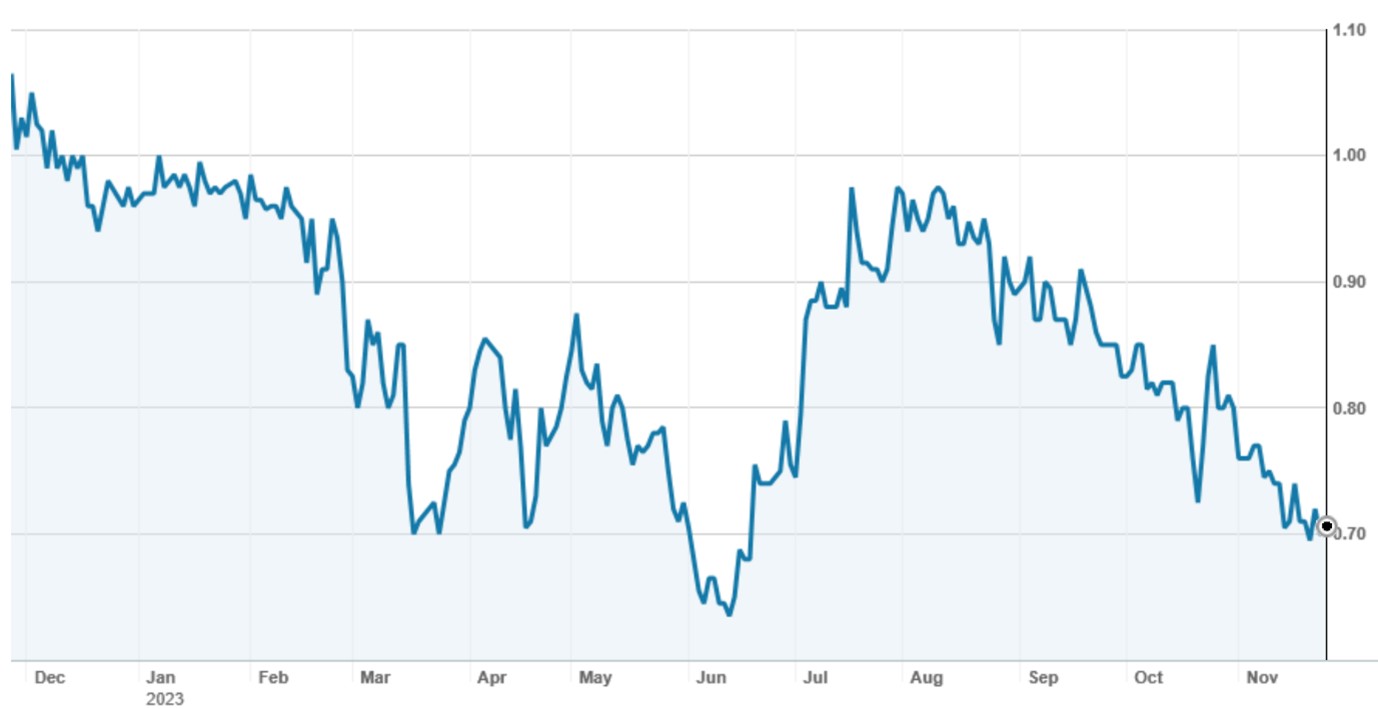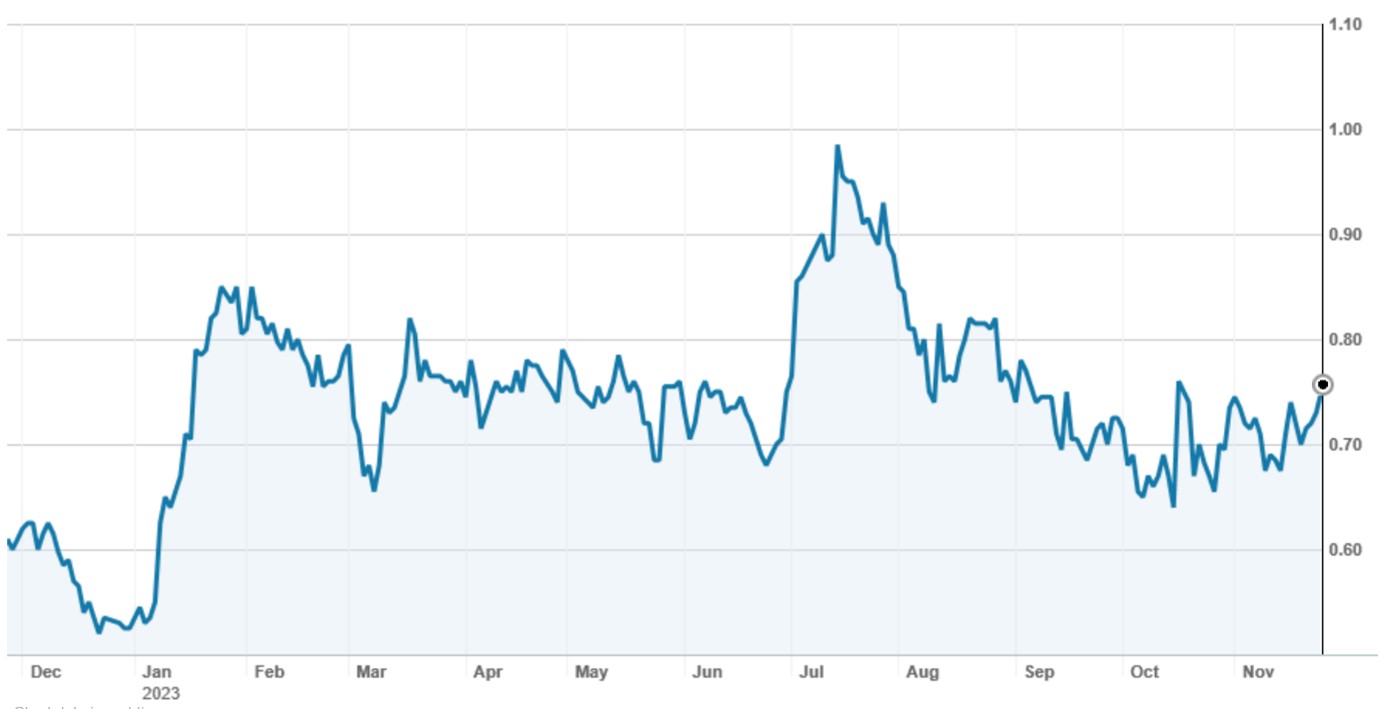Continuing the theme of stocks priced at certain levels that look to be attractive buying, here are three highly interesting opportunities – in highly varied sectors of the share market – that all presently sit at 75 cents or lower.
- Alumina (AWC, 70.5 cents)
Market capitalisation: $2 billion
12-months total return: –54.1%
Three-year total return: –24.2% a year
Analysts’ consensus price target: 99.2 cents (Stock Doctor/Refinitiv, seven analysts), $1.13 (FN Arena, four analysts)
Alumina Limited’s sole asset is its 40% interest in the Alcoa World Alumina and Chemicals (AWAC) joint venture, which mines bauxite, extracts alumina (aluminium oxide) and smelts aluminium. It has about 25% of the global alumina market. Alcoa owns the other 60% of AWAC and is the operator of the joint venture.
Alumina has had a dire year on the ASX, more than halving in price. In August, the company reported a US$42.9 million underlying half-year loss, and failed to announce an interim dividend – an unacceptable performance from what has usually been a strong dividend source. But signs of a turnaround can be seen.
Alumina (AWC) – last 12 months

Source: nabtrade
Alumina has been battling several problems, not least of which is that demand for aluminium and alumina remains tepid. The alumina price slid from US$417 a tonne at the end of 2021 to US$319 at the end of 2022, on the back of weak aluminium demand outside China and lower industry costs of production and is still hovering around US$326 a tonne. But there is evidence of a tight global balance for alumina and a recovery in aluminium production in China that could improve the price.
In the June 2023 half year, AWC’s realised alumina price came in at US$361 a tonne, down 9% on the US$398 a tonne it achieved in the June 2022 half. The realised price for aluminium at US$2,453 a tonne fared worse, down 25% on the US$3,280 struck for the same half.
Another issue in 2023 has been poor productivity at the company’s three alumina refineries in Western Australia, which have struggled as AWAC has been unable to access higher-grade bauxite, because its mining management plans (MMPs) are tied up in a drawn-out regulatory approval process with the WA government, with environmental groups increasing the pressure on the company in terms of submissions to the government and the state Environmental Protection Authority (EPA). Having to mine lower-grade bauxite has pushed up production costs and hurt the operation’s profitability.
Also, AWAC’s San Ciprian refinery in Spain found itself on the wrong side of unhedged exposure to rapidly rising European gas prices. In response, AWAC reduced production to 50% of its nameplate capacity, but costs stubbornly held above the alumina price. Ordinarily, AWAC could have fed San Ciprian with low-cost ore from Western Australia – but the problems at that source mean this option is off the table, and the losses at San Ciprian are not going to be solved quickly.
Not only energy, but prices for caustic soda, a crucial input, have also hurt AWAC.
But analysts are just starting to see light at the end of the tunnel, with the operational performance starting to improve, and most of the issues firmly baked-in to the share price. A positive ruling in WA allowing access to higher-grade bauxite would be highly positive for the share price. AWAC has submitted a revised MMP through to FY27, and while the ball is in the state government’s court, analysts are mostly positive about the likely outcome – on a more-likely-than-not basis.
On the back of this, the price targets for AWC are fairly bullish: Morgan Stanley is the most positive, projecting $1.40. And in terms of total return, Stock Doctor/Refinitiv’s sample of seven analysts sees dividends resuming next year (Alumina uses the calendar year as its financial year), with a 2.3-Australian-cent fully franked dividend; FN Arena’s sample, from four analysts, sees 3.3 Australian cents. Assuming full franking, that puts the prospective grossed-up yield for AWC at 4.7%–6.7%.
- hipages (HPG, 70 cents)
Market capitalisation: $93 million
12-months total return: –33.6%
Three-year total return: –33.1% a year
Analysts’ consensus price target: $1.352 (Stock Doctor/Refinitiv, four analysts)
Listed on the Australian Securities Exchange (ASX) in November 2020, the Sydney-based hipages Group operates Australia and New Zealand’s largest online marketplaces for tradespeople, along with workflow management SaaS (software-as-a-service) platform Tradiecore.
The hipages online marketplace lets homeowners and commercial customers find and hire reputable tradespeople; it offers customers an easy three-step process to get competitive quotes from trusted professionals on their home improvement projects. The Tradiecore SaaS product helps tradespeople power their business by giving access to quality leads or opportunities to connect with homeowners, and handling crucial tasks, from quoting and invoicing through to scheduling jobs, collecting payment and managing cash flow.
In October, HPG signed a deal with global technology consultancy Thoughtworks to roll-out a one-stop platform tailored for tradespeople. This platform – into which Tradiecore is being integrated – will offer one cohesive app that will encapsulate everything that a tradesperson needs to seamlessly run their business. It promises efficiency, time-saving features, and opportunities to boost revenue and customer retention. The end-to-end platform houses functions like customer lead management, materials sourcing, scheduling, payments – it is designed to be a comprehensive solution for tradespeople, and hipages hopes it can “win” the entire tradie ecosystem in Australia and New Zealand – in which $110 billion is spent each year. This “platform strategy” is designed to further extend the lifetime value of a customer.
The key numbers for hipages are annual recurring revenue (ARR) and average revenue per user (ARPU). On a monthly basis, recurring revenue rose by 14% over financial year 2023, to $6.3 million. ARPU increased 10%, to $1,872.
In FY23, hipages lifted revenue by 8%, to $67 million, with recurring revenue 94% of total revenue. EBITDA (earnings before interest, tax, depreciation and amortisation) before significant items rose 14%, to $12.3 million (the company made a net loss of $2.3 million, before significant items). Tradies subscribing to the platform were up 3%, to 35,700. At the end of the FY23 financial year hipages had $10.7 million of cash on hand and no debt.
The company reached the free cashflow-positive stage in the second half of FY23 and is targeting the same status for the full FY24; from that, analysts expect hipages to break through for its first net profit. The company has projected “low teens” percentage growth in revenue in FY24, with a “mid-teens” growth target over the medium term. The EBITDA (earnings before interest, tax, depreciation and amortisation) margin was 18% in FY23, up one percentage point from FY22; the medium-term target is to lift that to 25%.
As strong tradie activity – particularly in the home renovations market – results in more jobs being connected, and more tradie/customer connections drive more leads, hipages benefits from a “network effect” on both sides of the marketplace. The high job volume on the platform – there were 1.4 million jobs transacted in FY20 – means that hipages can provide opportunities for more profitable jobs for tradies, while customers benefit from a higher probability of matching with a tradie that meets their skills and needs.
hipages (HPG) – last 12 months

Source: nabtrade
hipages is not yet a profitable company, but it is heading in the right direction. Financial year 2024 will be a crucial year, but the network effect is a powerful force.
- Volpara Health Technologies (VHT, 75 cents)
Market capitalisation: $191 million
12-months total return: 13.6%
Three-year total return: –19.4% a year
Analysts’ consensus price target: 97.8 cents (Stock Doctor/Refinitiv, one analyst), $1.01 (FN Arena, two analysts)
New Zealand-based Volpara Health Technologies, which listed on the ASX in April 2016, has put together an impressive body of work, but like many biotech stocks, the share price got ahead of itself, and retraced significantly – but that means the current price could be a good buying opportunity.
Volpara Health Technologies (VHT) – last 12 months

Source: nabtrade
Volpara’s breast imaging analytics software is world-class, enabling doctors to catch breast cancer early. The software uses AI algorithms to analyse mammogram images and associated patient data to provide objective measures of the breast; and in particular, breast density, which is both a key indicator in early breast cancer detection, and a flaw in the current standard procedure of a mammogram X-ray, because breast density can hide cancer in a mammogram.
Studies suggest that mammograms detect only 65% of cancers in women with dense breasts: Volpara’s transformational software analyses breast density and also the probability of missing potential tumours, helping to determine whether further scans are required. The Volpara technology enables personalised, high-quality screening to give a better chance of early detection of breast cancer.
The software combines cancer risk assessment, density scoring, image-quality optimisation, patient tracking and reporting, workflow management, and automation for doctors, radiologists, technologists, and patients. It is used in more than 2,000 facilities around the world, touching nearly 15 million patients: Volpara says its annual recurring revenue (ARR) opportunity in breast cancer screening is USS$750 million ($1.1 billion). More than 75 million women are screened globally each year, and there are 500,000 deaths a year from breast cancer.
In March 2019, the US Food & Drug Administration (FDA) gave the Volpara technology a huge push, with its decision to introduce mandatory reporting of breast density in mammograms in the USA. Four years down the track, the FDA announced in March this year a federal regulation requiring all women to be notified if they have “dense” or “not dense” breasts in their mammography results letters. Effective. from 10 September 2024, all US women will be told, in standardised language, that dense tissue makes it harder to find cancer on mammograms and raises the risk of developing breast cancer.
The ruling is expected to encourage women to discuss their density and other risk factors with their radiologist or healthcare provider, and therefore increase the likelihood that cancers missed by mammograms are detected via screening tests such as ultrasound and magnetic resonance imaging (MRI). Volpara says this ruling—which is “one likely to save many lives”— is “the result of over a decade of hard work by Volpara and its advocate allies.”
The Volpara product is a software-as-a-service (SaaS) system to which hospitals and imaging companies subscribe. Volpara has now analysed more than 100 million breast images, which is the largest data set of mammograms available for R&D in the world. The company is working with Microsoft’s machine learning experts to develop from this database new algorithms, including one to detect and quantify, from a mammogram, breast arterial calcifications (BACs): this new tool takes Volpara into a new area of care, part of a US$146.4 billion ($222 billion) cardiovascular disease market. In July, Microsoft named Volpara its global Healthcare & Life Sciences Partner of the Year, chosen from more than 4,200 submitted nominations, from more than 100 countries.
Volpara reached positive operating net cash flow status in the third quarter of 2023 (the company uses the calendar year as its financial year) and repeated that in the fourth quarter. By the June 2023 half-year, it had notched its second straight half-year of positive free cash flow. In the meantime, Volpara is maintaining its 2023 revenue guidance of between NZ$40 million–$42 million (compared to NZ$28.7 million in 2022), and EBITDA guidance of NZ$500,000–$2 million (compared to a NZ$12.2 million loss in 2022). From this, analysts can see profitability within reach; broker Morgans, for example, projects net profit in the March 2025 quarter. (Morgans has a price target of $1.17 on the stock).
Volpara is not without competitors, but the company is making an excellent fist of growing revenue and notching milestones toward profitability. I think it’s one of the best biotech stocks on the ASX.
Important: This content has been prepared without taking account of the objectives, financial situation or needs of any particular individual. It does not constitute formal advice. Consider the appropriateness of the information in regard to your circumstances.